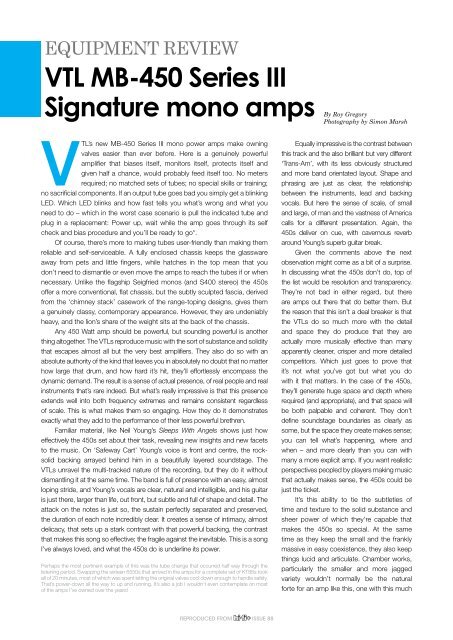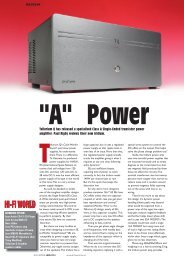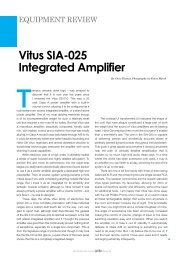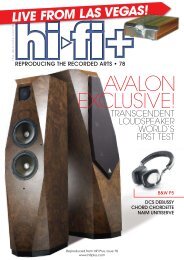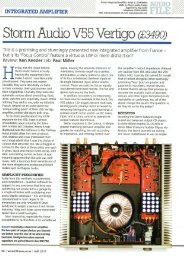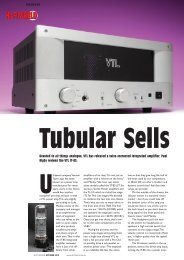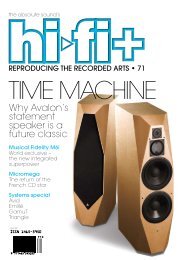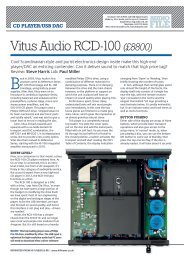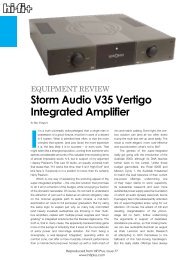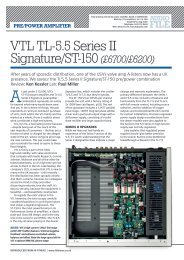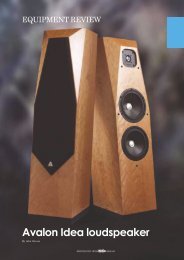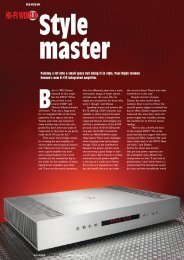VTL MB-450 Series III Signature mono amps - kog audio
VTL MB-450 Series III Signature mono amps - kog audio
VTL MB-450 Series III Signature mono amps - kog audio
Create successful ePaper yourself
Turn your PDF publications into a flip-book with our unique Google optimized e-Paper software.
Equipment Review<br />
<strong>VTL</strong> <strong>MB</strong>-<strong>450</strong> <strong>Series</strong> <strong>III</strong><br />
<strong>Signature</strong> <strong>mono</strong> <strong>amps</strong><br />
By Roy Gregory<br />
Photography by Simon Marsh<br />
<strong>VTL</strong>’s new <strong>MB</strong>-<strong>450</strong> <strong>Series</strong> <strong>III</strong> <strong>mono</strong> power <strong>amps</strong> make owning<br />
valves easier than ever before. Here is a genuinely powerful<br />
amplifier that biases itself, monitors itself, protects itself and<br />
given half a chance, would probably feed itself too. No meters<br />
required; no matched sets of tubes; no special skills or training;<br />
no sacrificial components. If an output tube goes bad you simply get a blinking<br />
LED. Which LED blinks and how fast tells you what’s wrong and what you<br />
need to do – which in the worst case scenario is pull the indicated tube and<br />
plug in a replacement: Power up, wait while the amp goes through its self<br />
check and bias procedure and you’ll be ready to go*.<br />
Of course, there’s more to making tubes user-friendly than making them<br />
reliable and self-serviceable. A fully enclosed chassis keeps the glassware<br />
away from pets and little fingers, while hatches in the top mean that you<br />
don’t need to dismantle or even move the <strong>amps</strong> to reach the tubes if or when<br />
necessary. Unlike the flagship Seigfried <strong>mono</strong>s (and S400 stereo) the <strong>450</strong>s<br />
offer a more conventional, flat chassis, but the subtly sculpted fascia, derived<br />
from the ‘chimney stack’ casework of the range-toping designs, gives them<br />
a genuinely classy, contemporary appearance. However, they are undeniably<br />
heavy, and the lion’s share of the weight sits at the back of the chassis.<br />
Any <strong>450</strong> Watt amp should be powerful, but sounding powerful is another<br />
thing altogether. The <strong>VTL</strong>s reproduce music with the sort of substance and solidity<br />
that escapes almost all but the very best amplifiers. They also do so with an<br />
absolute authority of the kind that leaves you in absolutely no doubt that no matter<br />
how large that drum, and how hard it’s hit, they’ll effortlessly encompass the<br />
dynamic demand. The result is a sense of actual presence, of real people and real<br />
instruments that’s rare indeed. But what’s really impressive is that this presence<br />
extends well into both frequency extremes and remains consistent regardless<br />
of scale. This is what makes them so engaging. How they do it demonstrates<br />
exactly what they add to the performance of their less powerful brethren.<br />
Familiar material, like Neil Young’s Sleeps With Angels shows just how<br />
effectively the <strong>450</strong>s set about their task, revealing new insights and new facets<br />
to the music. On ‘Safeway Cart’ Young’s voice is front and centre, the rocksolid<br />
backing arrayed behind him in a beautifully layered soundstage. The<br />
<strong>VTL</strong>s unravel the multi-tracked nature of the recording, but they do it without<br />
dismantling it at the same time. The band is full of presence with an easy, almost<br />
loping stride, and Young’s vocals are clear, natural and intelligible, and his guitar<br />
is just there, larger than life, out front, but subtle and full of shape and detail. The<br />
attack on the notes is just so, the sustain perfectly separated and preserved,<br />
the duration of each note incredibly clear. It creates a sense of intimacy, almost<br />
delicacy, that sets up a stark contrast with that powerful backing, the contrast<br />
that makes this song so effective; the fragile against the inevitable. This is a song<br />
I’ve always loved, and what the <strong>450</strong>s do is underline its power.<br />
Perhaps the most pertinent example of this was the tube change that occurred half way through the<br />
listening period. Swapping the sixteen 6550s that arrived in the <strong>amps</strong> for a complete set of KT88s took<br />
all of 20 minutes, most of which was spent letting the original valves cool down enough to handle safely.<br />
That’s power-down all the way to up and running. It’s also a job I wouldn’t even contemplate on most<br />
of the <strong>amps</strong> I’ve owned over the years!<br />
Equally impressive is the contrast between<br />
this track and the also brilliant but very different<br />
‘Trans-Am’, with its less obviously structured<br />
and more band orientated layout. Shape and<br />
phrasing are just as clear, the relationship<br />
between the instruments, lead and backing<br />
vocals. But here the sense of scale, of small<br />
and large, of man and the vastness of America<br />
calls for a different presentation. Again, the<br />
<strong>450</strong>s deliver on cue, with cavernous reverb<br />
around Young’s superb guitar break.<br />
Given the comments above the next<br />
observation might come as a bit of a surprise.<br />
In discussing what the <strong>450</strong>s don’t do, top of<br />
the list would be resolution and transparency.<br />
They’re not bad in either regard, but there<br />
are <strong>amps</strong> out there that do better them. But<br />
the reason that this isn’t a deal breaker is that<br />
the <strong>VTL</strong>s do so much more with the detail<br />
and space they do produce that they are<br />
actually more musically effective than many<br />
apparently cleaner, crisper and more detailed<br />
competitors. Which just goes to prove that<br />
it’s not what you’ve got but what you do<br />
with it that matters. In the case of the <strong>450</strong>s,<br />
they’ll generate huge space and depth where<br />
required (and appropriate), and that space will<br />
be both palpable and coherent. They don’t<br />
define soundstage boundaries as clearly as<br />
some, but the space they create makes sense;<br />
you can tell what’s happening, where and<br />
when – and more clearly than you can with<br />
many a more explicit amp. If you want realistic<br />
perspectives peopled by players making music<br />
that actually makes sense, the <strong>450</strong>s could be<br />
just the ticket.<br />
It’s this ability to tie the subtleties of<br />
time and texture to the solid substance and<br />
sheer power of which they’re capable that<br />
makes the <strong>450</strong>s so special. At the same<br />
time as they keep the small and the frankly<br />
massive in easy coexistence, they also keep<br />
things lucid and articulate. Chamber works,<br />
particularly the smaller and more jagged<br />
variety wouldn’t normally be the natural<br />
forte for an amp like this, one with this much<br />
REPRODUCED FROM ISSUE 88
EQUIPMENT REVIEW / <strong>VTL</strong> <strong>MB</strong>-<strong>450</strong> <strong>Series</strong> <strong>III</strong> <strong>Signature</strong> Mono <strong>amps</strong><br />
power constantly on tap. Yet, once again,<br />
playing the Julian Bream Consort’s recording<br />
of Britten’s ‘Courtly Dances’ from Gloriana,<br />
the <strong>VTL</strong>s surprise and delight. These modern<br />
compositions are based on Elizabethan<br />
themes and fragments. The <strong>450</strong>s don’t<br />
just bring a real sense of body to these half<br />
dozen instruments, giving each a richness of<br />
harmonic character, a depth of colour that<br />
brings extraordinary presence and vibrance<br />
to the performance, they effortlessly decode<br />
this musical alloy, separating the authentically<br />
Elizabethan elements from the modern<br />
finery in which they’re<br />
dressed. And again, far from<br />
detracting from the music, it<br />
actually reveals another layer<br />
in the structure, another level<br />
of sense in the performance.<br />
As well as the highly<br />
sophisticated circuitry that<br />
sets and monitors the<br />
individually bias and screen<br />
voltages throughout the<br />
amp, the Mk <strong>III</strong> version<br />
of this long-running<br />
design adds several other<br />
significant features. The<br />
input and driver stages are<br />
now fully differential. The<br />
single-ended inputs get their<br />
own, J-fet derived current<br />
source, meaning that the<br />
<strong>audio</strong> circuits can run in<br />
balanced mode irrespective<br />
of the type of input. The<br />
revised circuit uses a shorter,<br />
faster feedback loop,<br />
whilst eliminating global<br />
feedback entirely, yet the<br />
amp remains unconditionally<br />
stable without any form of<br />
capacitive compensation.<br />
And talking of eliminating<br />
capacitors, all those in the<br />
signal path are now Mundorf<br />
silver-in-oil types, while the<br />
reservoir caps have been<br />
bypassed with film caps.<br />
Last and by no means least,<br />
the output transformers have<br />
been totally redesigned and<br />
are now heavily interleaved,<br />
bifilar wound and fully balanced. As before, small soft-touch buttons on the<br />
front-panel allow you to switch from stand by to full power, to mute the amp<br />
and also to switch from tetrode to triode output mode. The latter delivers 200<br />
Watts into 8 Ohms but to these ears it sacrifices the authority and musical<br />
coherence that make the <strong>450</strong>s special. (If your system sounds better with<br />
these <strong>amps</strong> switched to triode output, I’m sorry, but you’ve probably got some<br />
work to do elsewhere in the set up.) Last, but by no means least, owners of<br />
the Mk II version can have their <strong>amps</strong> upgraded. Having heard both, I wouldn’t<br />
hesitate if I were you…<br />
As well as the natural ability to drive pretty much any loudspeaker that goes<br />
hand in hand with a <strong>450</strong> Watt output arriving via a decent transformer, the <strong>VTL</strong>s<br />
also offer a variable damping factor (whose operation is described in more detail<br />
in the sidebar). Assuming that <strong>amps</strong> like these are likely to partner large and<br />
REPRODUCED FROM ISSUE 88
EQUIPMENT REVIEW / <strong>VTL</strong> <strong>MB</strong>-<strong>450</strong> <strong>Series</strong> <strong>III</strong> <strong>Signature</strong> Mono <strong>amps</strong><br />
Changes and Choices…<br />
demanding<br />
loudspeakers,<br />
easily able to stress the<br />
listening environment, this offers a welcome<br />
and worthwhile degree of additional finetuning<br />
when it comes to getting control of<br />
your system and in particular, its bottom end.<br />
Which brings us to the <strong>450</strong>s’ other<br />
surprising strength, their natural sense of<br />
musical flow and articulation. Again, this is not<br />
something one normally expects from really<br />
powerful <strong>amps</strong>, the way you don’t expect<br />
fast feet and delicate handling from frontrow<br />
forwards. Yet the lucid, unobstructive<br />
ease with which the <strong>VTL</strong>s let music find its<br />
own pace, structure and phrasing repeatedly<br />
surprises and beguiles, although you’ll need<br />
to choose your pre-amp with care.<br />
Get it right and the <strong>amps</strong> will simply<br />
step away from the system, leaving the<br />
music just as fleet of foot as it needs to be.<br />
So Britten’s angular rhythmic jolts present<br />
no challenge, in the same way that Vivaldi’s<br />
Concerto For Lute And Strings is all crisp<br />
precision and perfectly pitched phrases. The<br />
quick articulate playing of the lute is perfectly<br />
placed against the longer notes of the Bass<br />
Viol, its delicacy in the largo a perfectly<br />
plucked counterpoint to the bowed notes of<br />
the larger instrument. Move up in scale and<br />
the <strong>amps</strong> are just as comfortable, so perhaps<br />
it’s time to surrender to the inevitable and,<br />
finally, big it up…<br />
Berglund’s Sibelius symphonic cycle on<br />
EMI is one of the great recordings from this<br />
massive catalogue. Selecting the Second<br />
Symphony, a master class in contained<br />
musical power and its measured release, it<br />
was time to let the <strong>VTL</strong>s loose on what could<br />
be considered their favoured terrain.<br />
As well as <strong>VTL</strong>s sophisticated autobias<br />
and tube monitoring circuitry, the<br />
<strong>Series</strong> <strong>III</strong> <strong>Signature</strong> incarnation of the <strong>450</strong> also<br />
offers the user a variable damping factor facility. Each<br />
amp offers a pair of toggle switches, mounted beneath the chassis<br />
cover, between the valve banks, allowing the selection of four different<br />
damping factors, ranging from Low through to Very High. This is all<br />
about matching the amp to the speaker and listening environment –<br />
once set it should be left well alone. In effect, these switches alter the<br />
output impedance of the amplifier (by varying the amount of negative<br />
feedback) and the grip it exerts over the speaker. And grip they do.<br />
Set the damping to Very High and the <strong>450</strong>s exert a vice like hold over<br />
the speakers, a level of control that would be the envy of many a solidstate<br />
device. The cost, just like so many of those big solid-state <strong>amps</strong>, is<br />
rather more than a hint of dryness. Back off by stages on the damping<br />
and the sound blossoms and opens out, becoming freer and more<br />
fluid. What the four-position control allows you is the luxury of selecting<br />
exactly where you want, or need, to be on that continuum, opening<br />
up the possibility to compensate for speakers or rooms that are too dry,<br />
rather too loose or bass that gets a bit enthusiastic.<br />
The other big decision facing <strong>450</strong> owners is the choice of output<br />
tubes. The amp can be shipped with either Electro Harmonix 6550C<br />
or Tungsol Gold Lion KT88 glassware. But while the tubes might be<br />
interchangeable, their sound is not and materially affects the sonic<br />
character of the amplifier. The 6550C delivers a full, warm, weighty<br />
sound with tremendous drive and solidity. They seem to forcibly<br />
propel the music into the room, delivering a big, bold sound with<br />
tremendous impact and power. In contrast, the KT88s deliver a more<br />
delicate, refined and articulate sound, with greater transparency,<br />
air and space. They make music and playing more agile, delivering<br />
greater texture and a more natural sense of shape.<br />
So, on a track like Shawn Colvin’s ‘Shotgun Down The Avalanche’<br />
the 6550s provide plenty of low-frequency foundation and drive,<br />
really driving the track along. Plug in the KT88s and you’ll discover two<br />
things: one, that you need to advance the volume control a couple<br />
of notches to match the apparent power of the 6550s and two, that<br />
once you do so the bottom-end takes on its familiar, undulating shape.<br />
Likewise, play Kleiber’s<br />
Beethoven 7th Symphony,<br />
the sublime opening of the<br />
second movement, and the<br />
contrast between the two<br />
tube sets is just as stark.<br />
The differences here<br />
are real and significant.<br />
If experience suggests<br />
that moving the system<br />
in either direction might<br />
be worthwhile, it’s worth<br />
serious consideration.<br />
REPRODUCED FROM ISSUE 88
EQUIPMENT REVIEW / <strong>VTL</strong> <strong>MB</strong>-<strong>450</strong> <strong>Series</strong> <strong>III</strong> <strong>Signature</strong> Mono <strong>amps</strong><br />
The subtle, swelling of the opening bars<br />
reveals a broad and deep acoustic space. The<br />
instrumental groupings of the Bournemouth<br />
Symphony are nicely placed with a natural<br />
perspective and no exaggeration of height.<br />
Depth is good, with a discernable rear wall;<br />
width and overall height are less clearly<br />
delineated. But what really strikes you is the<br />
effortless sense of power, allied to a clear<br />
sense of musical direction. Berglund gives us<br />
Technical Specifications<br />
Type: Tetrode-coupled valve <strong>mono</strong>-bloc<br />
Valve Complement (each): 1x 12AT7; 1x<br />
12BH7; 8x 6550C or KT88<br />
Inputs: 1x XLR; 1x RCA<br />
Input Sensitivity: 2.0V for full output<br />
Input Impedance: 42 kOhms<br />
Outputs: 1pr 5-way binding posts<br />
Optimum Load Range: 4 – 8 Ohms<br />
Rated Output: 425 Watts (Tetrode); 200<br />
Watts (Triode)<br />
Dimensions (WxHxD): 480 x 230 x 460mm<br />
Weight: 42kg ea.<br />
Finishes: Black or silver front panel; Black<br />
chassis<br />
Price: £17,500 per pair<br />
Manufactured by: <strong>VTL</strong> Amplifiers Inc.<br />
URL: www.vtl.com<br />
Manufactured by: Kog Audio<br />
Net: www.<strong>kog</strong><strong>audio</strong>.com<br />
Tel: +44(0)24 7722 0650<br />
Perfect Partners…<br />
For some, though sadly not all, of the review period, I also had the<br />
latest version of the <strong>VTL</strong> 6.5 pre-amp on hand. This one-box sibling of<br />
the established and highly-respected 7.5 looks on paper to be the<br />
<strong>450</strong>s’ natural partner, and so it proved in practice. Used in tandem,<br />
the <strong>VTL</strong> combination simply seemed to let the <strong>amps</strong> do their thing.<br />
Together they possess such an uninhibited sense of form and flow<br />
that whether it’s the line-stage feeding the <strong>amps</strong> what they want or<br />
simply getting out of the way and acceding to their demands quickly<br />
ceases to matter. Once again we have evidence that – in terms of<br />
the price/performance equation at any rate – that the virtues of the<br />
pairing are significantly greater than the sum of the parts. I’ll revisit<br />
the 6.5 at a later date, but for now let’s just say that anybody listening<br />
to the <strong>450</strong>s should make the effort to also hear them fed by the 6.5.<br />
This versatile and capable performer provides all the facilities and<br />
sophistication that we’ve come to expect in these days of multiroom,<br />
multi-source installations. It also offers exceptionally engaging<br />
musical results in a user friendly, single-box design. That makes it<br />
nearly as unusual as the <strong>450</strong>s it partners so enthusiastically!<br />
a reading with a real sense of purpose and that’s just what the <strong>450</strong>s deliver;<br />
there’s never any doubt where this performance is going. The <strong>VTL</strong>s keep<br />
everything pointing the same way, binding all the threads together, building<br />
and building them as Berglund demonstrates his mastery over both the score<br />
and the forces beneath his baton. Just when you think that the music can’t<br />
get any more intense, he releases the pressure in a long, long slide before<br />
ramping it up once again into one of the great orchestral climaxes.<br />
What’s so impressive here is not just the easy way in which the <strong>450</strong>s scale<br />
the dynamic demands of this powerful performance, but the absolute stability<br />
within the soundstage. Throughout, the drums are planted, clearly defined<br />
both in terms of weight and also texture, the brass never climbs forward even<br />
in the most enthusiastic tutti. It’s an oft overlooked quality in a system, but<br />
one that’s central to maintaining the illusion of a live performance. Playing<br />
Berglund’s Sibelius Two on the <strong>VTL</strong>s is a musical tour de force.<br />
Most of the really memorable <strong>audio</strong> products that have passed through<br />
my hands have at least one quality that sets them apart, and <strong>VTL</strong>’s <strong>450</strong> <strong>mono</strong>blocs<br />
are no different in that respect. In this case it’s the way they fasten on<br />
and reveal the nature of the music and the recording. Not what’s being played,<br />
or even how – but why.<br />
In an ideal world I’d want more detail, I’d want more<br />
micro-dynamic definition and greater clarity of the spaces<br />
around and between the instruments and players. But<br />
this isn’t an ideal world and the question is, just what<br />
would you be prepared to sacrifice in order to achieve<br />
those gains? In the case of the <strong>VTL</strong> <strong>450</strong>s that’s a hard one<br />
to answer and after considerable thought I’d take them just<br />
the way they are. Here is the pot of gold at the end of this<br />
particular rainbow – the high-powered valve amp that you<br />
can live with AND love. So much music, so few flaws and none<br />
of them intrusive, this is an amp that’s finally come of age: More than<br />
that, it’s one for the ages.<br />
+<br />
REPRODUCED FROM ISSUE 88


